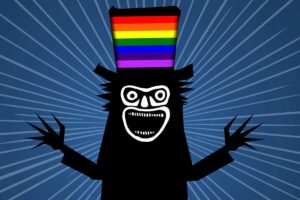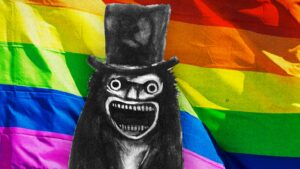 The Babadook is a 2014 Australian horror film that is considered a classic of its genre. It tells the story of Amelia, a grieving young widow, and seven-year-old Sam, her out-of-control son. Somehow the film’s “monster,” inexplicably, has become what many call a “queer” icon. How did that happen?
The Babadook is a 2014 Australian horror film that is considered a classic of its genre. It tells the story of Amelia, a grieving young widow, and seven-year-old Sam, her out-of-control son. Somehow the film’s “monster,” inexplicably, has become what many call a “queer” icon. How did that happen?
In my time I’ve seen about 43,671 horror movies—give or take—which leaves me prone to being jaded. But I swear, The Babadook seriously weirded me out. In a nutshell, the aforementioned young widow finds a children’s book called “Mister Babadook” on her son’s bookcase. Amelia doesn’t recall seeing it before, but what the heck, she reads it to him anyway and unleashes the Kraken, or in this case the creepy title character. After that, there is nothing she can do to rid herself and her son from the presence of this entity. (Check out my post, “Films About Books: The Babadook.”)
There were some who posited that Mister Babadook was a metaphor for the terrible grief that Amelia felt over the death of her husband, and that grief, like the monster, will never go away entirely. This culminates in Amelia and Sam’s ultimate acceptance of the entity.
 But what does this have to do with the LGBTQ community? It might have started with a Tumblr post claiming that Mister Babadook was a symbol for a gay man seeking acceptance. A subsequent post supporting this thought said that, to the LGBTQ community, Mister Babadook was a symbol of their journey. Naturally, these posts took on a life of their own and were shared worldwide. It was even thought that the film was listed by Netflix in its LGBT movies section. Whatever the case, Mister Babadook is now a frontline icon for Gay Pride.
But what does this have to do with the LGBTQ community? It might have started with a Tumblr post claiming that Mister Babadook was a symbol for a gay man seeking acceptance. A subsequent post supporting this thought said that, to the LGBTQ community, Mister Babadook was a symbol of their journey. Naturally, these posts took on a life of their own and were shared worldwide. It was even thought that the film was listed by Netflix in its LGBT movies section. Whatever the case, Mister Babadook is now a frontline icon for Gay Pride.
To be honest, I’m not totally sure that I understand the phenomenon, though I do find it fascinating. Out of numerous articles, I offer links to two: The Daily Beast: “Scene by Scene, This is What Make The Babadook Such an LGBT Icon,” and Vox: “How The Babadook Became the LGBTQ Icon we Didn’t Know we Needed.”
